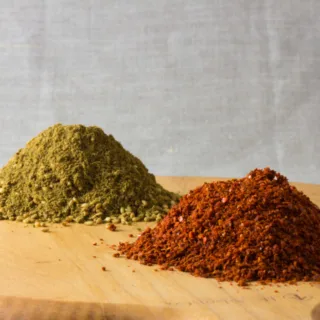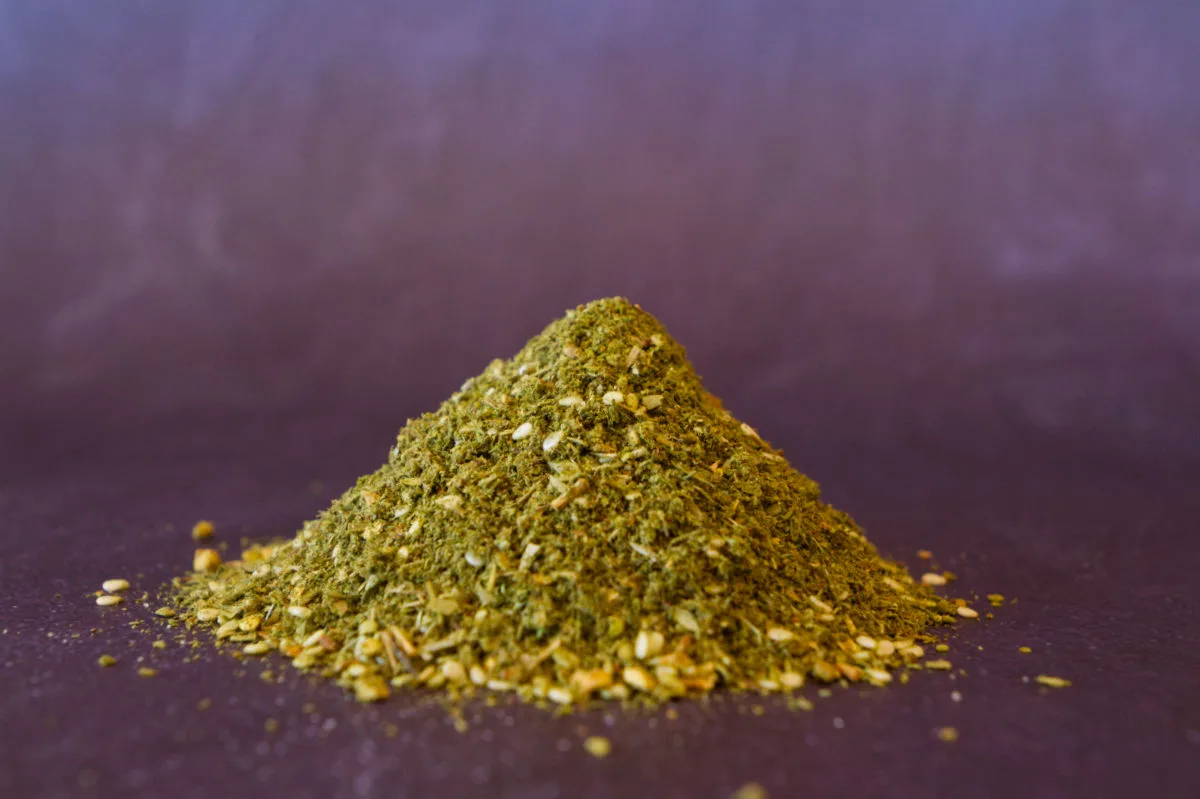Za’atar is a fragrant herb and spice blend that has culinary significance in various countries across the Middle East, including Lebanon, Syria, Jordan, Israel, Palestine, and countries bordering the Mediterranean Sea. The history of za’atar dates back to ancient times, when it was valued for its flavor and believed medicinal properties.
But what exactly constitutes this aromatic mix and what are its associated health benefits? While the exact recipe can vary by region, Za’atar is essentially a combination of dried and ground wild herbs and spices, as well as sesame seeds, sumac (a tangy and red-hued spice), and salt.
Let’s delve into the spicy world of Za’atar.
Table of contents:
What is in Za’atar?
Za’atar is a quintessential Middle Eastern herb and spice blend composed primarily of a wild herb closely related to oregano, marjoram, and wild thyme (known as Za’atar), sesame seeds, sumac, and salt.
The exact ingredients can vary by region, but the combination usually brings out a toasty, tangy, or nutty flavor. It’s commonly sprinkled over olive oil-drizzled bread or used in dips, salads, meat, and vegetable seasonings.
The History of Za’atar
The history of Za’atar dates back to ancient times, when it was valued for its flavor and believed medicinal properties. It’s mentioned in various historical texts and religious scriptures. In some Middle Eastern cultures, za’atar is thought to have aphrodisiac properties, and it has been associated with enhancing mental clarity and focus.
Za’atar has been used by different civilizations that inhabited the Middle East, including the Ancient Egyptians, Greeks, and Romans. The mixture was considered a staple in their diets and often used as a seasoning, as well as a preservative due to the antibacterial properties of thyme and other herbs.
In modern times, Za’atar continues to be an integral part of Middle Eastern cuisine. It’s used in a wide range of dishes, from savory pastries and roasted meats to salads and dips. Its popularity has also spread beyond the Middle East, with people around the world incorporating it into their cooking and experimenting with its versatile flavors.
How to Make Za’atar at Home
Making Za’atar at home is quite simple and allows you to customize the blend to your taste preferences. Here’s a basic recipe for making Za’atar:
Equipment
- Medium-sized pan or skillet
- Small mixing bowl
- Mortar and Pestle
- Sealable jar or airtight container
Ingredients
- 2 tablespoons dried thyme
- 1 tablespoon toasted sesame seeds
- 1 tablespoon ground sumac
- 1 teaspoon dried oregano or marjoram (optional)
- Salt to taste (about 1/2 teaspoon)
Instructions
Step 1 – Toast the Sesame Seeds:
In a dry skillet over medium heat, toast the sesame seeds until they turn golden brown and become fragrant. Keep an eye on them, as they can burn quickly. Once toasted, remove from heat and let them cool.
Step 2 – Mix the Ingredients:
In a bowl, combine the dried thyme, toasted sesame seeds, ground sumac, dried oregano or marjoram (if using), and salt.
Step 3 – Blend:
You can use a mortar and pestle to lightly crush the ingredients together, or simply mix them with a spoon. The goal is to create a uniform mixture while still maintaining some texture.
Step 4 – Taste and Adjust:
Taste the za’atar mixture and adjust the seasoning according to your preference. You can add more salt, sumac, or any other ingredient to balance the flavors to your liking.
Step 5 – Store:
Transfer the za’atar blend to an airtight container and store it in a cool, dry place. It should stay fresh for several months.
How to Use Za’atar in Cooking
- Use homemade Za’atar blend as a seasoning for grilled meats, roasted vegetables, or salads.
- Mix it with olive oil to create a dip for bread or drizzle over dishes.
- Sprinkle it over hummus or other dips.
- Use it as a topping for flatbreads, such as manakish.
Za’atar recipes vary from one region to another and even among families. Experiment with the ratios and ingredients to create a blend that suits your taste preferences.
Health Benefits of Za’atar
Za’atar isn’t just a flavorful addition to your dishes; it’s packed with health benefits. The blend boasts potent nutrients and organic compounds such as thymol, gallic acid, carvacrol, and quercetin. Check out these great health benefits:
- Immunity Boost: Za’atar has the ability to improve the immune system, which is essential for overall health.
- Skin and Bone Health: The rich mineral content of Za’atar promotes the health of the skin and strengthens bones.
- Respiratory Health: The blend helps in clearing out respiratory tracts and soothes inflammation, making it beneficial for those with respiratory issues.
- Mood and Memory Enhancer: Consuming Za’atar can lead to improved mood and better memory, potentially helping in conditions like dementia.
- Cancer Prevention: Sumac, a component of Za’atar, is rich in quercetin which can neutralize free radicals and potentially prevent cancer proliferation.
- Antioxidant Properties: Za’atar is loaded with flavonoids, which are known for having antioxidant properties. Antioxidants play a vital role in protecting cells from damage.
- Antiseptic and Fungicidal Properties: Both thymol and carvacrol present in Za’atar have been identified to possess antiseptic and fungicidal properties, which can be beneficial in various infections.
The benefits of Za’atar aren’t just a recent discovery. Historically, figures in the 12th century recognized the health-advancing properties of Za’atar and prescribed it for various ailments. Moreover, Za’atar’s reputation as a health food is ancient. It’s been used as a remedy for flu, eczema, period cramps, colds, nerves, stomach aches, and more.
With its delightful taste and impressive health benefits, it’s no surprise that Za’atar is gaining popularity beyond the Middle East. Whether you’re sprinkling it on a salad, integrating it into your main dish, or simply enjoying it with bread and olive oil, this seasoning blend not only tantalizes your taste buds but also boosts your health.
See the Nutrition Facts section below for more information.
Za’atar FAQs
What’s the shelf life of Za’atar?
Store in an airtight container, away from direct sunlight, and za’atar will remain good for about 6 months.
What can I use Za’atar in?
It’s commonly eaten for breakfast in the Middle East with some olive oil on bread. You can also use it in salads, on pizzas, in marinades, and desserts or sweet breakfasts (think pancakes with honey or maple syrup and some za’atar sprinkled on top).
Where can I buy Za’atar?
Most Middle Eastern grocery stores or specialty spice shops will have it. It’s also very easy to find it online. Here is a good place to start if you’re in the US, UK, Canada, or Australia.
Nutrition Facts for Za’atar
| Servings: 8 | |
| Amount per serving | |
| Calories | 10 |
| % Daily Value* | |
| Total Fat 0.6g | 1% |
| Saturated Fat 0.1g | 1% |
| Cholesterol 0mg | 0% |
| Sodium 26mg | 1% |
| Total Carbohydrate 3.2g | 1% |
| Dietary Fiber 0.6g | 2% |
| Total Sugars 0.2g | |
| Protein 0.3g | |
| Vitamin D 0mcg | 0% |
| Calcium 27mg | 2% |
| Iron 1mg | 6% |
| Potassium 14mg | 0% |
| *The % Daily Value (DV) tells you how much a nutrient in a food serving contributes to a daily diet. 2,000 calorie a day is used for general nutrition advice. | |

Za’atar: A Middle Eastern Herb and Spice Blend
Equipment
- Medium-sized pan or skillet
- Small mixing bowl
- Mortar and pestle
- Sealable jar or airtight container
Ingredients
- 2 tablespoons dried thyme
- 1 tablespoon toasted sesame seeds
- 1 tablespoon ground sumac
- 1 teaspoon dried oregano or marjoram optional
- Salt to taste about 1/2 teaspoon
Instructions
Step 1 – Toast the Sesame Seeds:
- In a dry skillet over medium heat, toast the sesame seeds until they turn golden brown and become fragrant. Keep an eye on them, as they can burn quickly. Once toasted, remove from heat and let them cool.
Step 2 – Mix the Ingredients:
- In a bowl, combine the dried thyme, toasted sesame seeds, ground sumac, dried oregano or marjoram (if using), and salt.
Step 3 – Blend:
- You can use a mortar and pestle to lightly crush the ingredients together, or simply mix them with a spoon. The goal is to create a uniform mixture while still maintaining some texture.
Step 4 – Taste and Adjust:
- Taste the za’atar mixture and adjust the seasoning according to your preference. You can add more salt, sumac, or any other ingredient to balance the flavors to your liking.
Step 5 – Store:
- Transfer the za’atar blend to an airtight container and store it in a cool, dry place. It should stay fresh for several months.


Leave a Reply